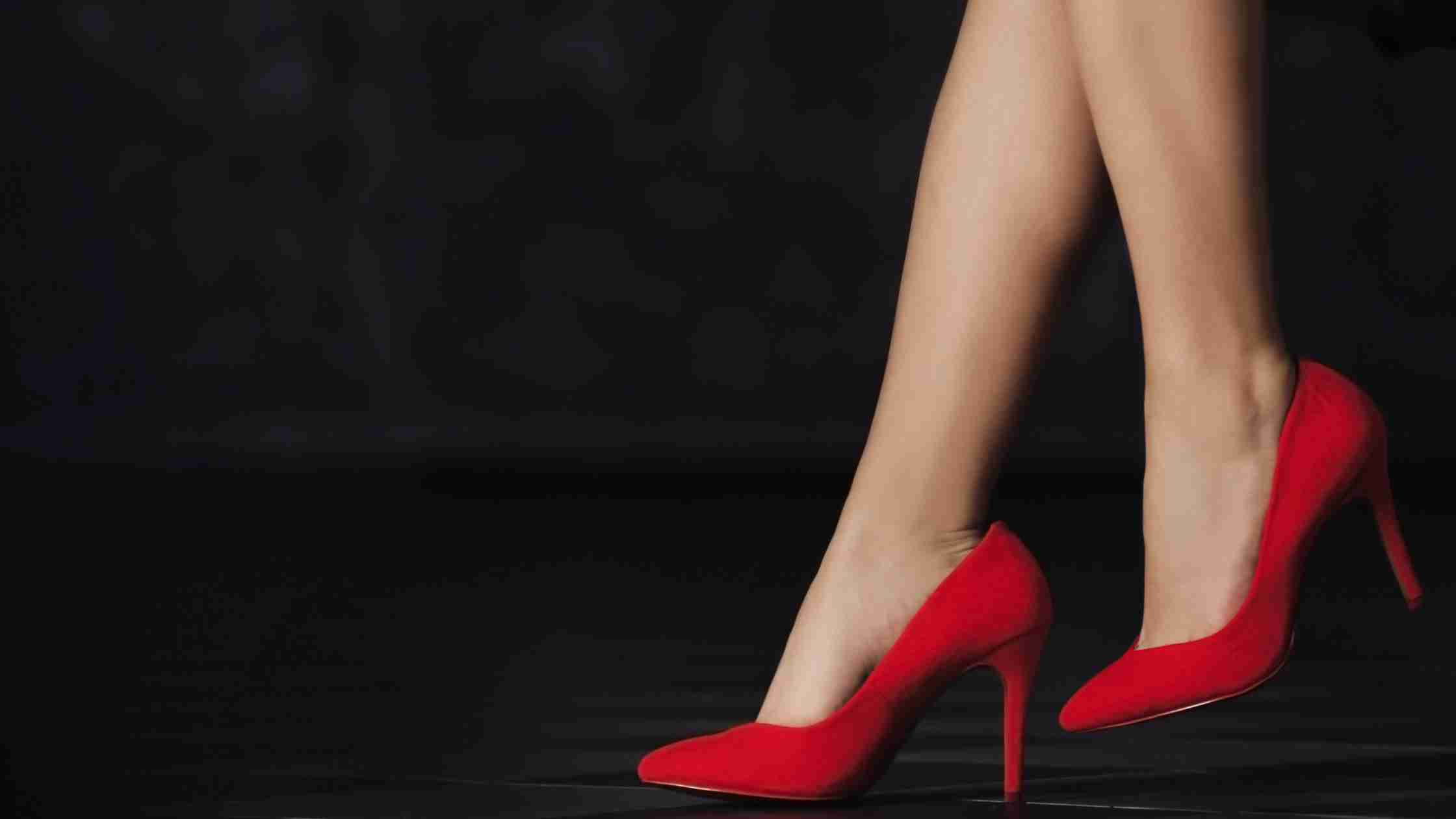We know, we know—you've got a lot to do today. You're probably thinking that you'd rather just wear your favourite pair of high heels, because they're comfortable and make you feel good about yourself.
But guess what? You could be doing yourself a huge disservice by wearing those shoes.
High heels are bad for your feet and bad for your body. They make you more prone to injury (anterior pelvic tilt) and cause postural problems, such as lower back pain (lumbar lordosis). We've put together this list to help you understand why a high heeled shoe is the worst thing ever:
They can be dangerous
High heels can also cause you to lose your balance and fall. This happens because the higher heel means your centre of gravity is altered, making it harder to keep your footing. If you wear high heels often, this can lead to injury over time as well as more frequent falls. This is just one of the many studies to prove that a high heel will lead to poor posture as it affects your gait. Ankle sprains could become more common, and you might need a foot massage quite often. The right body posture enables injury prevention. A lower heel is better for functional mobility than a high heel. A physical therapist will advice you to wear a flat shoe instead for proper posture.
Many people have twisted an ankle while wearing high heels! The curvature of the shoe makes it more likely for your foot to roll inwards, which could lead to a severe ankle sprain or fracture if not attended quickly enough after falling on hard ground like concrete or stone flooring (for example). By contrast, flat-soled shoes have less of a tendency for rolling inward when standing still or walking slowly—so they may actually be safer overall even though they don't look as glamorous!
They can cause instability
The first thing to know is that high heels can cause your ankles to roll inwards. That's because they put you on your toes, which is a position quite different from the way humans are made to stand. You're supposed to have your weight distributed evenly between all four corners of your feet, but if you're wearing heels, some of that weight has been transferred up into our toes and away from the heel. The result is that one small part of the foot bears more pressure than it should—and this puts extra strain on muscles and ligaments in your lower leg as well as on tendons farther up in your ankle joint (or even higher, if you have an old injury around there). This can lead to discomfort and pain, especially when walking for long distances or standing still for long periods of time—which happens pretty much every day when you work!
And then there's what happens inside of your lower body: High heels tend to cause knee collapse inwards; hips tilting forwards; shoulders rolling forwards; backs arching backwards (or at least appearing so). All these things make it harder for ladies to move around efficiently—which makes sense if you think about it: If someone told you that you had 10 seconds before being crushed by falling rocks, you'd probably start running too fast!
They can affect your perception
One study found that women wearing high heels were more likely to notice a man's face than a woman's. They also noticed the male face faster than the female one, even if the image was in black and white.
Another study showed that women wearing high heels were more likely to notice a man's face than they were images of food or other items.
They may cause back pain
High heels can put a lot of pressure on the back muscles and ligaments, causing tightness and pain.
As you walk in high heels, the Achilles tendon stretches to help absorb shock as your toes hit the ground to take each step. The calf muscle is then activated more than usual to support that movement. All this extra activity puts stress on your lower back—the lumbar spine—which has to work harder than usual to keep your body upright and stop you from falling over. This can lead to pain along the length of your spine or in specific areas such as low back muscles (lumbar).
They can hurt your feet
- Bunions: the bunion is a deformity of the joint at the base of the big toe, resulting in an enlarged bump and often pain. The big toe eventually points towards the other toes, which causes painful corns to form on its side.
- Corns: caused by friction between shoe and foot, corns can cause discomfort as well as blisters when walking or standing too long.
- Calluses: calluses are thickened areas of skin that develop when we repeat certain motions over time... they're not harmful but they can be uncomfortable and make it harder for you to walk properly if there's too much pressure on them from your shoes (and we've all had this happen before).
- Blisters: these are small cuts that develop between layers of skin due to friction with another object such as clothing or shoes; they're usually painful but will heal after awhile if given enough time (but don't try ripping open a blister yourself because you'll just keep getting infected!).
Can shorten tendons in your legs and feet
You probably know that tendons are tough fibres that connect muscles to bones, but did you know that they can also stretch? Tendons are elastic and can be stretched over time. This means wearing high heels for a long period of time can cause your tendons to get shorter!
This is because high heels force you to stand on your toes, so you can walk properly in them. Your toes take the pressure of your body weight instead of distributing it evenly across all parts of your foot (as would happen if you were wearing flat shoes), causing stress on the tendon connecting your calf muscle with the bone in your ankle. When this happens over and over again, it causes damage over time – like how repeatedly stressing one part of an elastic band will eventually break it.
Conclusion
- Wear shoes that are comfortable and safe. It’s important to wear shoes that are appropriate for the activity, fit properly and have good cushioning.
- Wear shoes that fit properly. The right shoe is one with a wide toe box for your toes to spread out, without pinching or squeezing your toes together; a heel counter (the rigid fabric on top of the heel) should feel snug around your ankle bone, but not tight or constricting; and heels should be low enough so you can walk comfortably in them without rolling an ankle.
- Wear shoes with good cushioning and ventilation. Cushioning helps absorb the shock of each step while walking or running so it’s easier on your joints; ventilation prevents sweat buildup by allowing air to circulate through the shoe's material—this helps keep feet dryer, warmer and more comfortable than if they were enclosed inside closed-toe footwear all day long!
- If you are suffering from an injury due to high heels, Posture Clinic is where you should head to for complete rehabilitation, and also to prevent future injuries.
Frequently Asked Questions
How often is it safe to wear heels?
Experts recommend wearing heels no more than once a week. If you're looking for a more comfortable, stylish shoe that works well with your lifestyle, they suggest trying out some flats!
How to avoid foot pain while wearing heels?
Make sure they're not too high. If your heel is more than 2 inches high, it can cause a lot of damage.
Do I have to wear socks with high heeled shoes?
Yes. Socks will keep your feet from sliding around in your shoes, which can cause blisters or other injuries.
How do I take care of my toes while wearing heels?
Make sure there is enough room for your toes in the front of a shoe. Otherwise, it might cause discomfort or even injury over time.
What happens to your feet when you wear heels every day?
Your feet start to change. You might notice that your toes feel cramped and stiff. Your arches might become flattened. You might get calluses on your heels from walking in them all the time. You might feel pain in your ankles or knees when you're wearing heels for a long period of time—that's because the muscles in your calves and thighs are having to work harder than usual to support your weight.
Should older people avoid heels altogether?
Yes, because the problem gets worse as you age. When you're younger, your tendons are more pliable and can adjust easily. But once you hit middle age or beyond, they become less flexible and may start to tear or sprain easily. That's why so many older people suffer from foot problems after years of wearing high heels!

